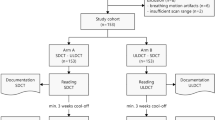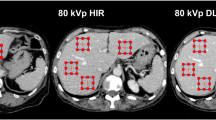Abstract
Objectives
Shaping the energy spectrum of the X-ray beam has been shown to be beneficial in low-dose CT. This study’s aim was to investigate dose and image quality of tin filtration at 100 kV for pre-operative planning in low-dose paranasal CT imaging in a large patient cohort.
Methods
In a prospective trial, 129 patients were included. 64 patients were randomly assigned to the study protocol (100 kV with additional tin filtration, 150mAs, 192x0.6-mm slice collimation) and 65 patients to the standard low-dose protocol (100 kV, 50mAs, 128 × 0.6-mm slice collimation). To assess the image quality, subjective parameters were evaluated using a five-point scale. This scale was applied on overall image quality and contour delineation of critical anatomical structures.
Results
All scans were of diagnostic image quality. Bony structures were of good diagnostic image quality in both groups, soft tissues were of sufficient diagnostic image quality in the study group because of a high level of noise. Radiation exposure was very low in both groups, but significantly lower in the study group (CTDIvol 1.2 mGy vs. 4.4 mGy, p < 0.001).
Conclusions
Spectral optimization (tin filtration at 100 kV) allows for visualization of the paranasal sinus with sufficient image quality at a very low radiation exposure.
Key Points
• Spectral optimization (tin filtration) is beneficial to low-dose parasinus CT
• Tin filtration at 100 kV yields sufficient image quality for pre-operative planning
• Diagnostic parasinus CT can be performed with an effective dose <0.05 mSv




Similar content being viewed by others
References
Hopper RA, Salemy S, Sze RW (2006) Diagnosis of midface fractures with CT: what the surgeon needs to know. Radiographics 26:783–793
Duvoisin B, Landry M, Chapuis L, Krayenbuhl M, Schnyder P (1991) Low-dose CT and inflammatory disease of the paranasal sinuses. Neuroradiology 33:4036
Tack D, Widelec J, De Maertelaer V, Bailly JM, Delcour C, Gevenois PA (2003) Comparison between low-dose and standard-dose multidetector CT in patients with suspected chronic sinusitis. AJR Am J Roentgenol 181:939–944
Kaur J, Chopra R (2010) Three dimensional CT reconstruction for the evaluation and surgical planning of mid face fractures: a 100 case study. J Maxillofac Oral Surg 9:323–328
Abul-Kasim K, Strombeck A, Sahlstrand-Johnson P (2009) Low-dose computed tomography of the paranasal sinuses: radiation doses and reliability analysis. Am J Otolaryngol 32:47–51
Hoang JK, Eastwood JD, Tebbit CL, Glastonbury CM (2010) Multiplanar sinus CT: a systematic approach to imaging before functional endoscopic sinus surgery. Am J Roentgenol 194:W527–W536
Perisinakis K, Raissaki M, Theocharopoulos N, Damilakis J, Gourtsoyiannis N (2005) Reduction of eye lens radiation dose by orbital bismuth shielding in pediatric patients undergoing CT of the head: a Monte Carlo study. Med Phys 32:1024–1030
Hein E, Rogalla P, Klingebiel R, Hamm B (2002) Low-dose CT of the paranasal sinuses with eye lens protection: effect on image quality and radiation dose. Eur Radiol 12:1693–1696
Brem MH, Zamani AA, Riva R et al (2007) Multidetector CT of the paranasal sinus: potential for radiation dose reduction. Radiology 243:847–852
Hagtvedt T, Aalokken TM, Notthellen J, Kolbenstvedt A (2003) A new low-dose CT examination compared with standard-dose CT in the diagnosis of acute sinusitis. Eur Radiol 13:976–980
Hojreh A, Czerny C, Kainberger F (2005) Dose classification scheme for computed tomography of the paranasal sinuses. Eur J Radiol 56:31–37
Wuest W, May MS, Brand M, Bayerl N, Krauss A, Uder M, Lell M (2015) Improved Image Quality in Head and Neck CT Using a 3D Iterative Approach toReduce Metal Artifact. AJNR Am J Neuroradiol 36(10):1988--93
Deak PD, Smal Y, Kalender WA (2010) Multisection CT protocols: sex- and age-specific conversion factors used to determine effective dose from dose-length product. Radiology 257:158–166
Landis JR, Koch GG (1977) The measurement of observer agreement for categorical data. Biometrics 33:159–174
Klein BE, Klein R, Linton KL, Franke T (1993) Diagnostic x-ray exposure and lens opacities: the Beaver Dam Eye Study. Am J Public Health 83:588–590
Chodick G, Bekiroglu N, Hauptmann M et al (2008) Risk of cataract after exposure to low doses of ionizing radiation: a 20-year prospective cohort study among US radiologic technologists. Am J Epidemiol 168:620–631
Yuan MK, Tsai DC, Chang SC et al (2013) The risk of cataract associated with repeated head and neck CT studies: a nationwide population-based study. AJR Am J Roentgenol 201:626–630
ICRP (2007) The 2007 Recommendations of the International Commission on Radiological Protection. ICRP Publication 103. 2007. Elsevier, Orlando
NCRP NCoRPaM (1985) Induction of thyroid cancer by ionizing radiation. NCRP report 80. NCRP Publications, Bethesda
Cohen MD (2009) Pediatric CT radiation dose: how low can you go? Am J Roentgenol 192:1292–1303
Aalokken TM, Hagtvedt T, Dalen I, Kolbenstvedt A (2003) Conventional sinus radiography compared with CT in the diagnosis of acute sinusitis. Dentomaxillofac Radiol 32:60–62
Hoxworth JM, Lal D, Fletcher GP et al (2014) Radiation dose reduction in paranasal sinus CT using model-based iterative reconstruction. AJNR Am J Neuroradiol 35:644–649
Acknowledgments
The scientific guarantor of this publication is Wolfgang Wuest. The authors of this manuscript declare no relationships with any companies whose products or services may be related to the subject matter of the article. The authors state that this work has not received any funding. One of the authors has significant statistical expertise. Institutional review board approval was obtained. Written informed consent was obtained from all subjects (patients) in this study. Methodology: prospective, randomised controlled, performed at one institution.
Author information
Authors and Affiliations
Corresponding author
Rights and permissions
About this article
Cite this article
Wuest, W., May, M., Saake, M. et al. Low-Dose CT of the Paranasal Sinuses: Minimizing X-Ray Exposure with Spectral Shaping. Eur Radiol 26, 4155–4161 (2016). https://doi.org/10.1007/s00330-016-4263-0
Received:
Revised:
Accepted:
Published:
Issue Date:
DOI: https://doi.org/10.1007/s00330-016-4263-0




